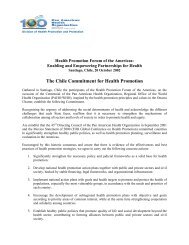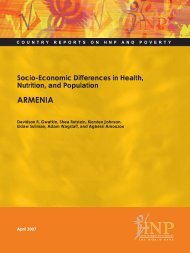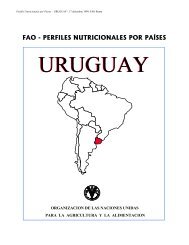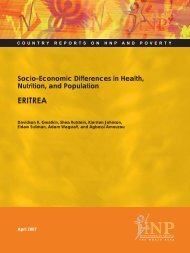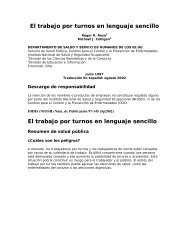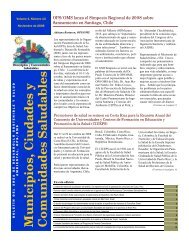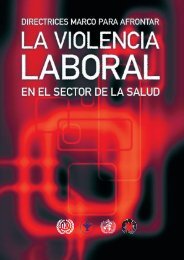Guidelines for drinking-water quality. Volume 1 - BVSDE
Guidelines for drinking-water quality. Volume 1 - BVSDE
Guidelines for drinking-water quality. Volume 1 - BVSDE
You also want an ePaper? Increase the reach of your titles
YUMPU automatically turns print PDFs into web optimized ePapers that Google loves.
it is not a genotoxic carcinogen and that genotoxic metabolites are not <strong>for</strong>med in relevant<br />
amounts in vivo.<br />
A TDI of 6 µg/kg of body weight was calculated by applying an uncertainty factor of 1000 (100 <strong>for</strong><br />
inter- and intraspecies variation and 10 reflecting concern <strong>for</strong> carcinogenic potential) to a NOAEL<br />
of 6 mg/kg of body weight per day <strong>for</strong> hepatotoxic effects in a 2-year <strong>drinking</strong>-<strong>water</strong> study in rats.<br />
This gives a guideline value of 20 µg/litre (rounded figure), allocating 10% of the TDI to <strong>drinking</strong><strong>water</strong>.<br />
It should be noted that widespread exposure from other sources is possible.<br />
1,1-Dichloroethane<br />
1,1-Dichloroethane is used as a chemical intermediate and solvent. There are limited data<br />
showing that it can be present in concentrations of up to 10 µg/litre in <strong>drinking</strong>-<strong>water</strong>. However,<br />
because of the widespread use and disposal of this chemical, its occurrence in ground <strong>water</strong> may<br />
increase.<br />
1,1-Dichloroethane is rapidly metabolized by mammals to acetic acid and a variety of chlorinated<br />
compounds. It is of relatively low acute toxicity, and limited data are available on its toxicity from<br />
short- and long-term studies.<br />
There is limited in vitro evidence of genotoxicity. One carcinogenicity study by gavage in mice<br />
and rats provided no conclusive evidence of carcinogenicity, although there was some evidence<br />
of an increased incidence of haemangiosarcomas in treated animals.<br />
In view of the very limited database on toxicity and carcinogenicity, it was concluded that no<br />
guideline value should be proposed.<br />
1,2-Dichloroethane<br />
1,2-Dichloroethane is used mainly as an intermediate in the production of vinyl chloride and other<br />
chemicals and to a lesser extent as a solvent. It has been found in <strong>drinking</strong>-<strong>water</strong> at levels of up<br />
to a few micrograms per litre. It is found in urban air.<br />
IARC has classified 1,2-dichloroethane in Group 2B. It has been shown to produce statistically<br />
significant increases in a number of tumour types in laboratory animals, including the relatively<br />
rare haemangiosarcoma, and the balance of evidence indicates that it is potentially genotoxic.<br />
There are no suitable long-term studies on which to base a TDI.<br />
On the basis of haemangiosarcomas observed in male rats in a 78-week gavage study, and<br />
applying the linearized multistage model, a guideline value <strong>for</strong> <strong>drinking</strong>-<strong>water</strong> of 30 µg/litre,<br />
corresponding to an excess lifetime cancer risk of 10 -5 , was calculated.<br />
1,1,1-Trichloroethane<br />
1,1,1-Trichloroethane has been found in only a small proportion of surface and ground <strong>water</strong>s,<br />
usually at concentrations of less than 20 µg/litre. In a few instances, much higher concentrations<br />
have been observed. There appears to be increasing exposure to 1,1,1-trichloroethane.<br />
1,1,1-Trichloroethane is rapidly absorbed from the lungs and gastrointestinal tract, but only small<br />
amounts - about 6% in humans and 3% in experimental animals - are metabolized. Exposure to<br />
high concentrations can lead to hepatic steatosis (fatty liver) in both humans and laboratory<br />
animals.<br />
IARC has placed 1,1,1-trichloroethane in Group 3. Available studies of oral administration were<br />
considered inadequate <strong>for</strong> calculation of a TDI. As there is an increasing need <strong>for</strong> guidance on<br />
this compound, a 14-week inhalation study in male mice was selected <strong>for</strong> use in calculating the




